If you are wondering what are the coolest freshwater fish to put in your aquarium, so that it beams with colorful, exotic and unique choices…
Below, you’ll discover 26 of our top picks to help you narrow down what colorful community fish to fill your tank with.
From beginner level to expert, and an easy care guide to reference, this guide is your go-to resource.
We’ve categorized the list into 3 sections:
Most Colorful
1. Betta
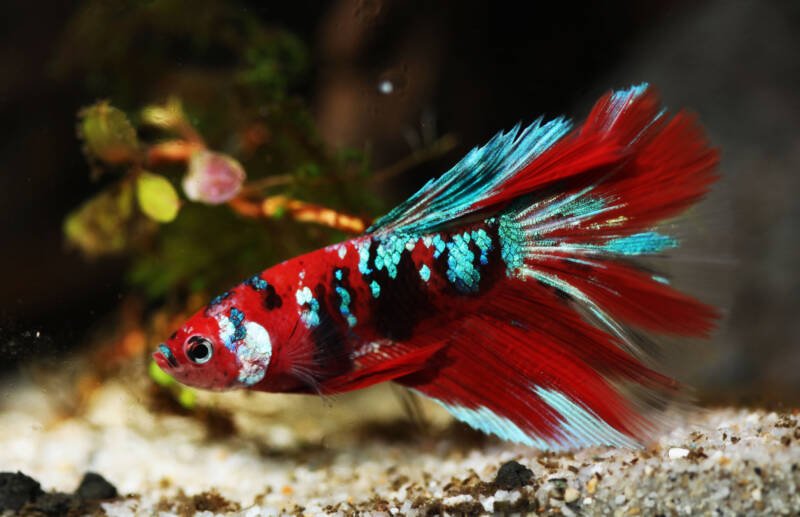
- Difficulty: Easy to Moderate
- Temperament: Aggressive
- Diet: Carnivore
- Tank Size: 5 gal (19 l)
Koi bettas are beautifully patterned betta fish with red, black, and white marble resembling their namesake.
They reach three inches in length (7.5 cm), have flowing fins, and are as easy to care for as their popular relatives.
Keep these fish in a well-planted tank with only one male or a group of at least five females. Males will be aggressive toward one another, while a group of females may coexist.
They can live in a community tank with peaceful, bottom-dwelling inhabitants. Strictly monitor water quality when using small tanks as the parameters can change quickly.
These fish can be fussy eaters, naturally preferring live prey, such as brine shrimp, to frozen or freeze-dried foods.
Other Betta varieties can be a great choice to add a bright featured fish for your tank!
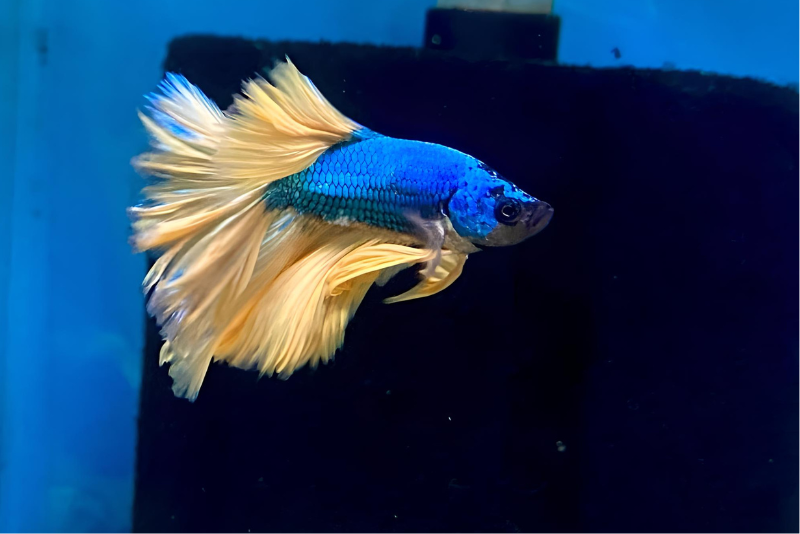
2. Discus (Symphysodon genus)
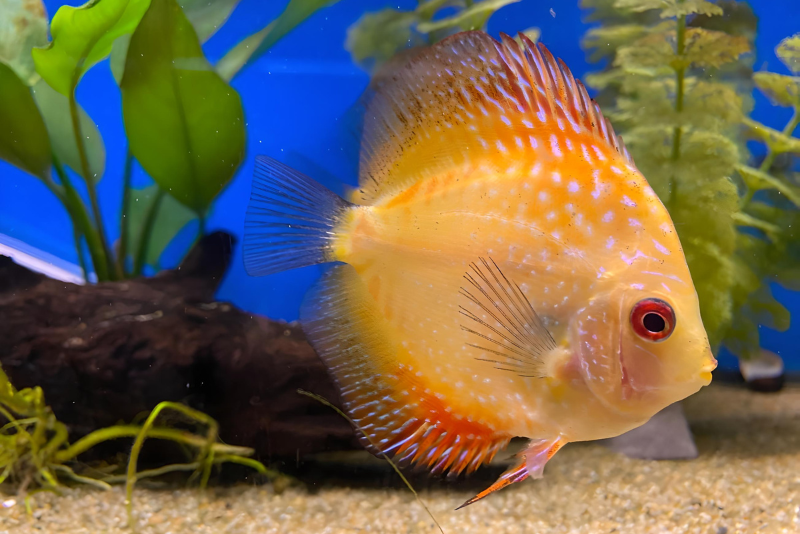
- Difficulty: Difficult
- Temperament: Peaceful
- Diet: Carnivore
- Tank Size: 75 gal (284 l)
- Size: 5-7 inches (13-18 cm)
Gently gliding in a wall of rainbow colors, the discus is undeniably a beautiful fish. The colors and patterns vary widely, pushing them up on the list of a spectacular centerpiece fish!
They have strict water requirements, needing exceptionally soft water; a narrow, slightly acidic pH range; and a limited, warm temperature range.
Nitrites and ammonia must be close to zero. Anything outside of these ranges can harm your fish.
These schooling fish grow between five and seven inches (13 to 18 cm) in diameter and do best in a group.
Buy and add them to the tank at the same time to reduce resource competition and always introduce your discus to the tank gradually.
Discus-only tanks work well as other species can outcompete them for food, but thoughtful pairing them with other fish can also work.
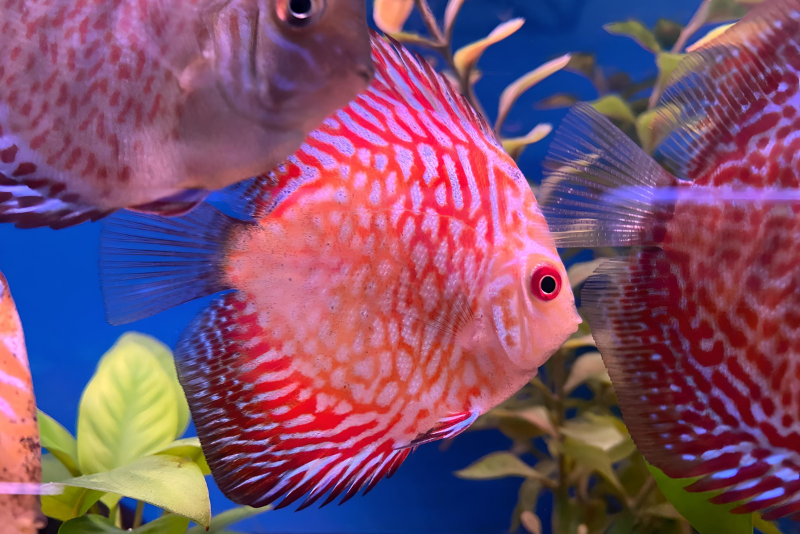
3. Female Kribensis (Pelvicachromis kribensis)
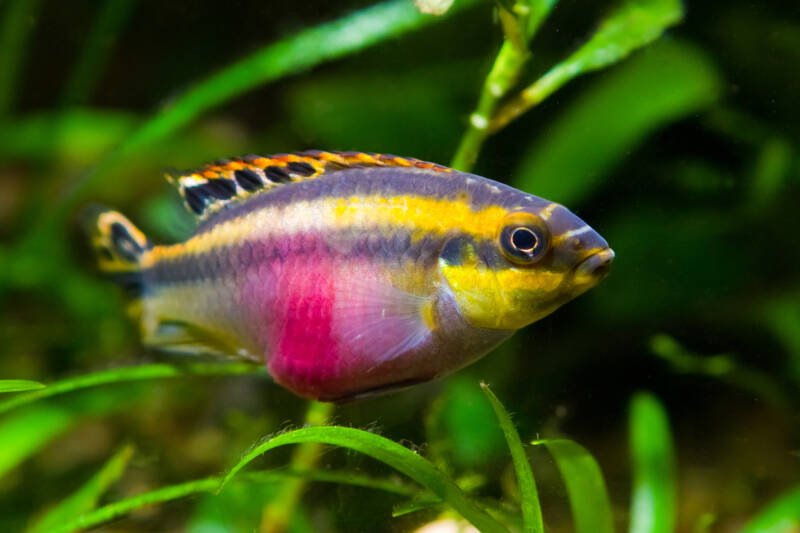
- Difficulty: Easy
- Temperament: Semi-aggressive
- Diet: Omnivore
- Tank Size: 20 gal (76 l)
Kribensis is a species where the female is more colorful than the male.
With a base color of silver, white, or grey, they have black stripes running the length of the body and red-tipped fins.
Females also have a prominent red spot on their abdomen and reach around three inches (7.6 cm) in length.
These fish have wonderfully interactive personalities. They are extremely hardy fish and can survive in a wide range of water pH, salinity, and hardness levels.
While you can keep them as a single specimen, you will find they display brighter colors when kept in pairs.
They are largely non-aggressive and somewhat shy, but when in a breeding pair, they can become territorial.
4. German Ram (Mikrogeophagus ramirezi) and Bolivian Ram (Mikrogeophagus altispinosus)
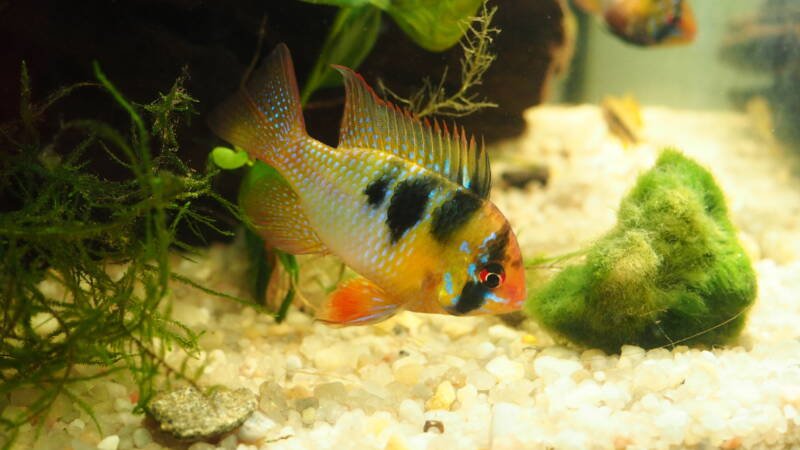
- Difficulty: Easy
- Temperament: Peaceful
- Diet: Omnivore
- Tank Size: 20 gal (76 l)
These cichlids are ideal for the beginning aquarist. The German ram is a stunning fish featuring blue, yellow, red, and orange colors.
The Bolivian ram has a more subtle red/orange/yellow color with attractive, swept-back fins.
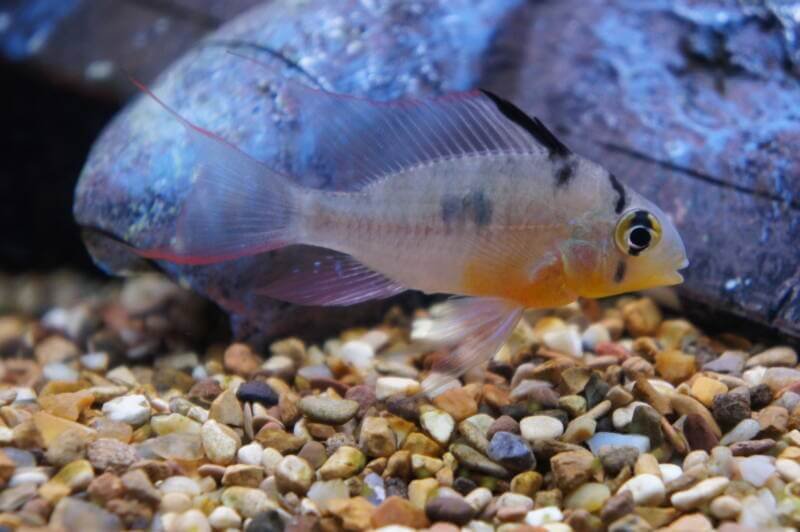
Both are small fish, maxing out around three inches (7.6 cm) in length, and both have a lifespan of around three to four years.
They are peaceful and excellent for community tanks. They need a heavily planted tank to keep stress levels down.
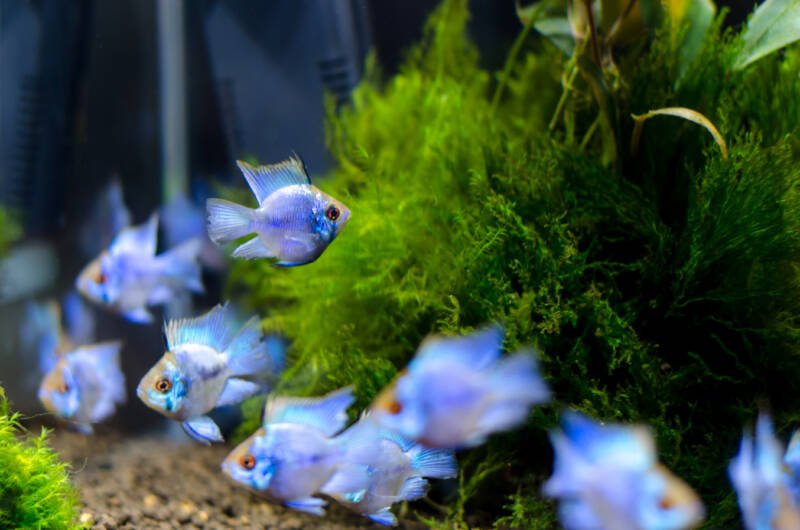
While German rams love to dig and uproot the very plants it needs, the Bolivian ram will not.
While they are hardy species, the German ram is more sensitive to shifts in water conditions than the Bolivian.
5. “Electric Blue” Jack Dempsey Cichlid (Rocio octofasciata)
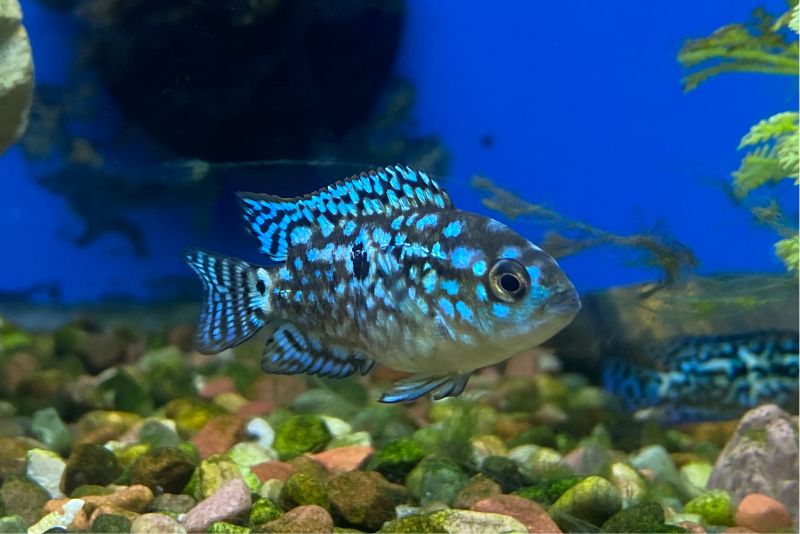
- Difficulty: Moderate
- Temperament: Aggressive
- Diet: Omnivore
- Tank Size: 55 gal (208 l)
- Size: 12 inches (30 cm)
You may have heard of the popular Jack Dempsey fish, but what about the “electric blue” variety? Its name describes its coloration perfectly – this fish is sure to be a standout addition in any tank!
They reach 12 inches (30 cm) in length as adults. Although these fish are calmer than their Jack Dempsey relations, they are predators and can be territorial, especially when spawning.
Keep them singly, in pairs, or with other Central or South American cichlids of comparable size.
Pay special attention to water temperature with this species, as a wide swing can be fatal.
They can be difficult to breed for an amateur aquarist as many of the resulting fry are not viable.
6. Cherry Barbs (Puntius titteya)
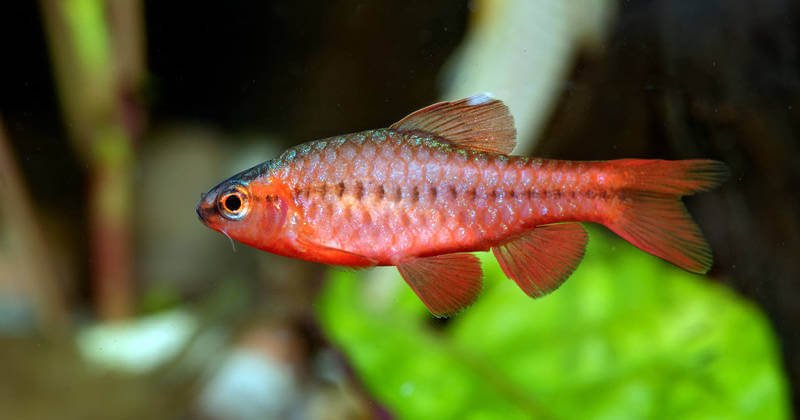
- Difficulty: Easy
- Temperament: Peaceful
- Diet: Omnivore
- Tank Size: 15 gal (57 l)
The cherry barb is a tiny size of one to two inches (2.5 to 5 cm). Their body, and even their eyes, are a brilliant red color, with a dark line stretching from the tip of the nose to the base of the tail.
This schooling species should not be kept as a single specimen but rather in a group of at least six to 10 fish. The presence of others will embolden the fish and allow the males to show brighter colors.
Balance your tank setup between planted areas and open swimming space.
Cherry barbs are safe to pair with small shrimp. They are not fin-nippers and can live with long-finned fish.
7. Gourami and Dwarf Gourami
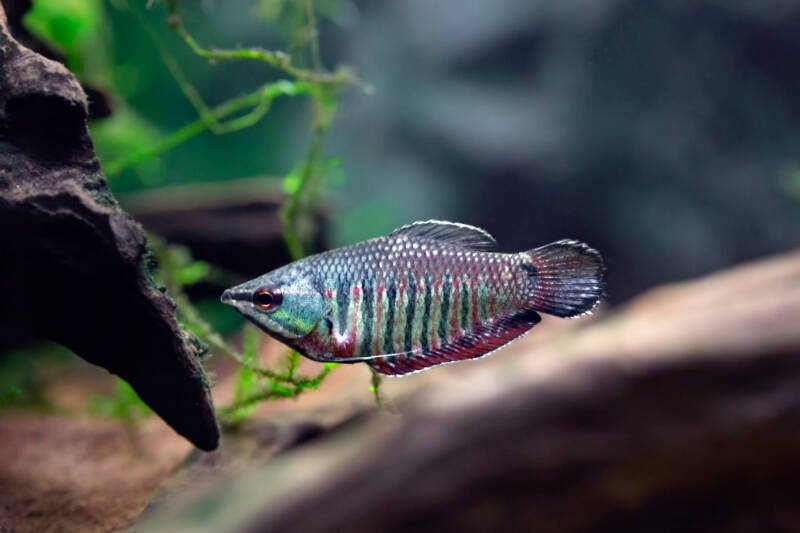
- Difficulty: Difficult
- Temperament: Peaceful
- Diet: Omnivore
- Tank Size: 20 gal (76 l)
- Size: 1.8 – 2.2 inches
In the wild, these freshwater fish thrive in heavily vegetated, oxygen-depleted waters using their labyrinth organ to help them breathe air at the water’s surface.
When young, both males and females are a light brown color to help them camouflage among decaying leaves. As they grow, the females become the more colorful of the two, sporting beautiful red and green stripes.
Their small adult size of around 1.8 to 2.2 inches (4.6 to 5.6 cm) means they can be kept in a modestly sized tank.
Pairing this fish with others can be tricky as they consider themselves rulers of the upper levels. Peaceful, slow-swimming, bottom-dwelling species are your best bet.
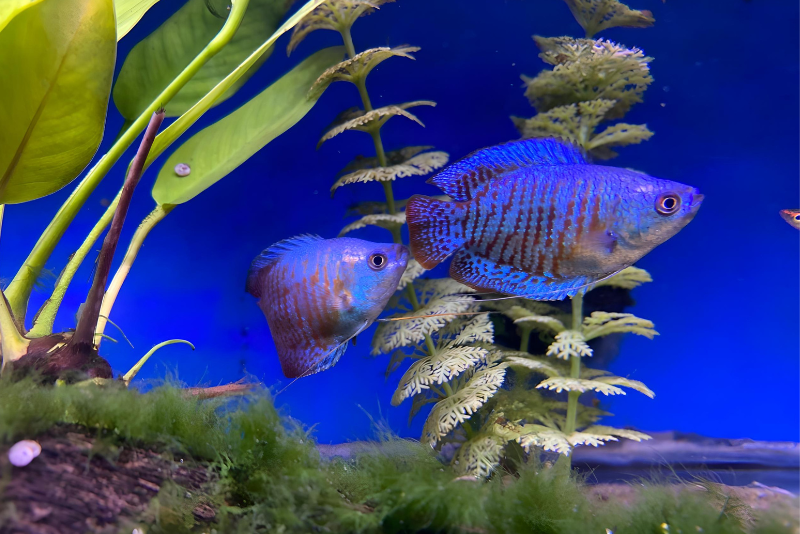
Gourami have been bred specifically to select the bright color variation and patterns. Be aware that with this extensive breeding, some Dwarf Gourami are weaker and not very hardy, so be sure to ask your source the breeding origin of the fish in consideration.
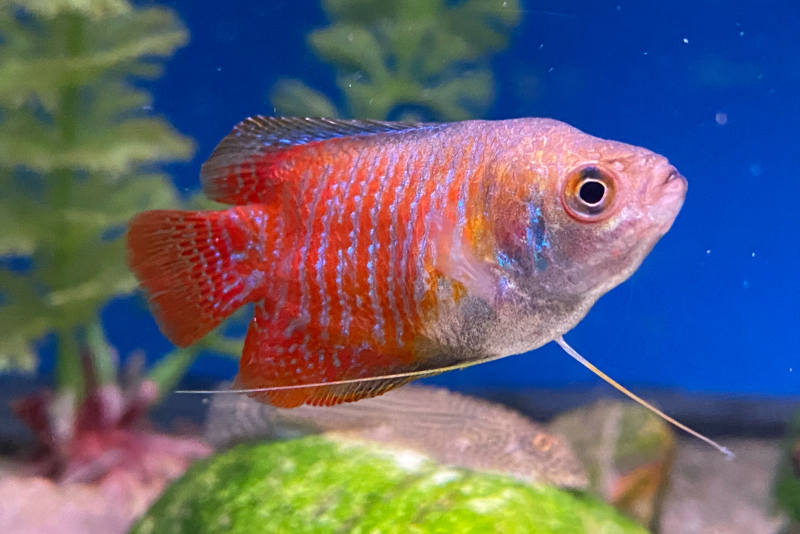
8. Threadfin Acara (Acarichthys heckelii)
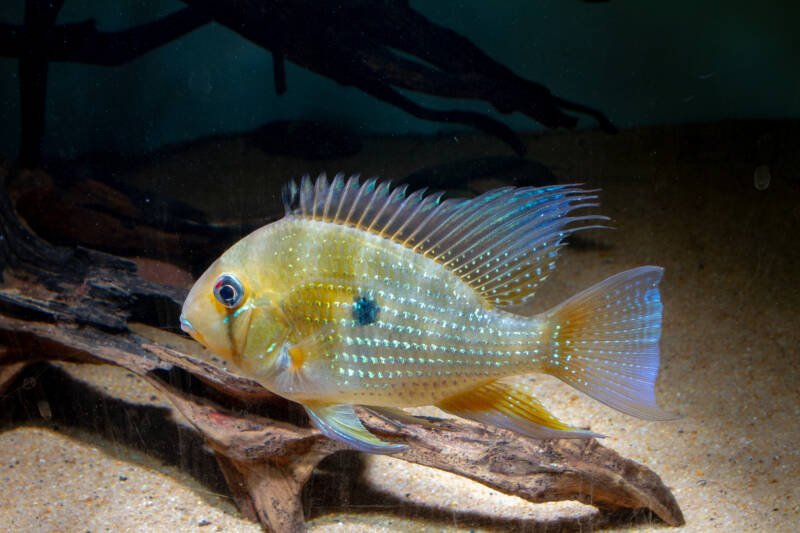
- Difficulty: Moderate
- Temperament: Peaceful
- Diet: Omnivore, with a heavy emphasis on meaty foods
- Tank Size: 90 gal (341 l)
- Size: 8 inches
The threadfin acara has a sleek body shape and endearing, oversized eyes. As this fish matures, so does its coloration, showing lovely blue-green dots and rainbow splashes of color on semi-transparent fins.
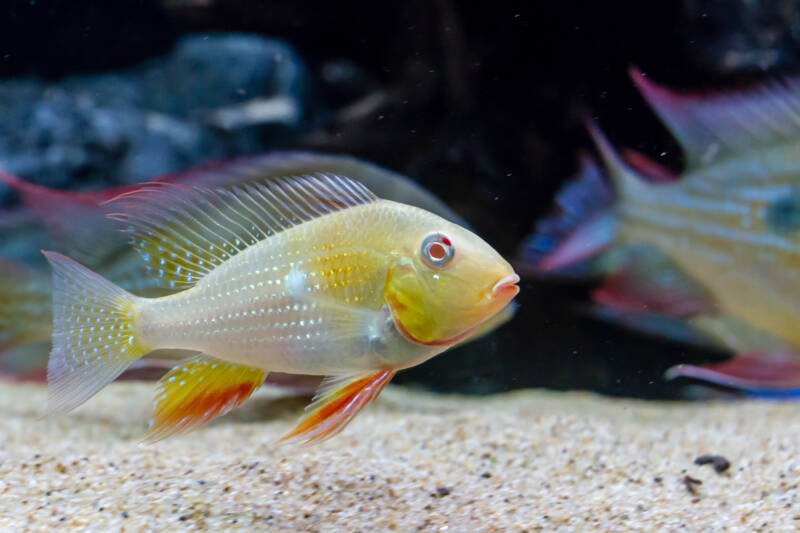
They are a peaceful cichlid species with plenty of personality. Threadfins can live in community tanks in groups, just pair them with species that are the same size or larger (8 inches, 20 cm).
The water should be meticulously cleaned and over-filtered to keep this species healthy.
These fish can be territorial during spawning and are constantly digging, so design your tank layout with this in mind.
Smaller tank sizes can increase stress for this species, resulting in an increased chance of aggression.
9. Apistogramma (genus)
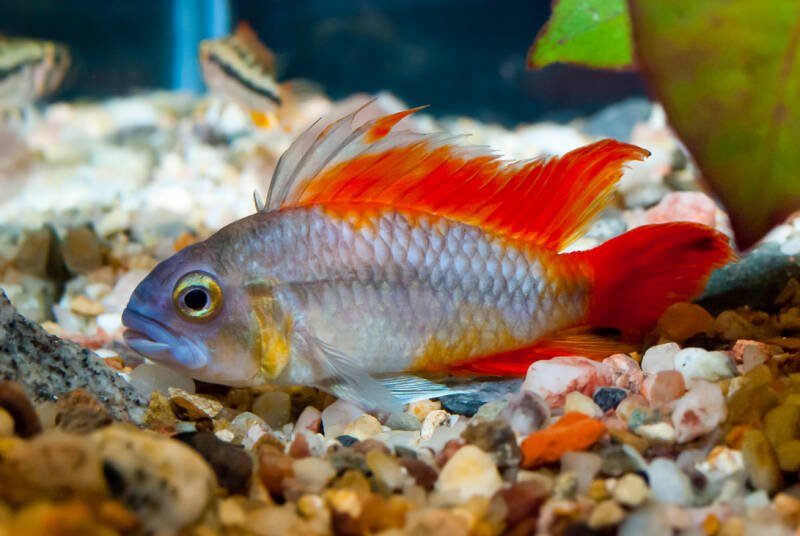
- Difficulty: Moderate
- Temperament: Semi-aggressive
- Diet: Omnivore
- Tank Size: 20 gal (76 l)
- Size: 0.8-4 inches (2-10 cm)
There are over 90 species under the Apistogramma genus, each one more colorful than the last. In addition, they playfully interact with and recognize their keepers, making them even more endearing.
Apistos are dwarf cichlids, with a range of sizes from a diminutive 0.8 inches (2 cm) to a maximum of four inches (10 cm), depending on the species.
They have a semi-aggressive, territorial nature and should not be paired with peaceful species.
Keep them in pairs or groups of four in an appropriately sized tank for the best chance of a peaceful environment.
Decorations, rocks, plants, and a sandy bottom will encourage your cichlid’s natural behaviors.
10. Blue-Eyed Forktail or Furcata Rainbowfish
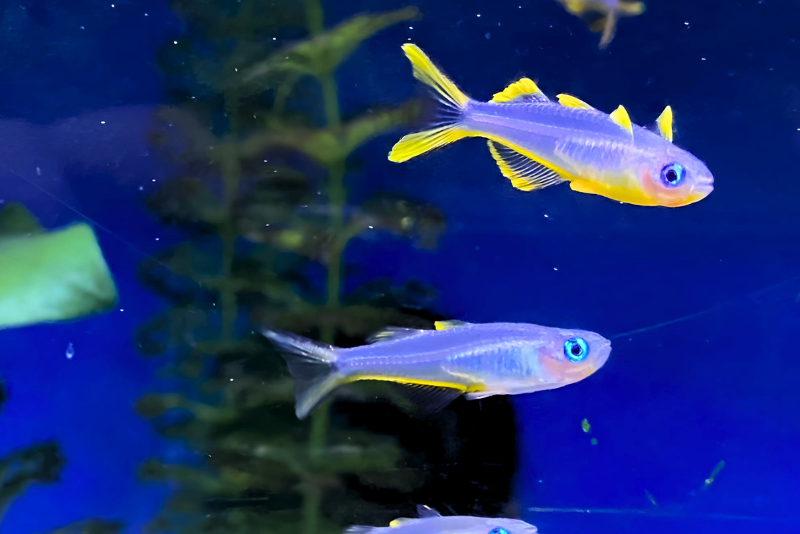
- Difficulty: Easy
- Temperament: Energetic and Curious
- Diet: Carnivore
- Tank Size: 10-20 gal (76 l)
- Size: 2 inches (5 cm)
These fish have a big appetite and are not finicky at all! They love blood worms, daphnia, krill flakes and much more.
Unique & Exotic
1. Royal Farlowella Catfish (Sturisoma panamense)
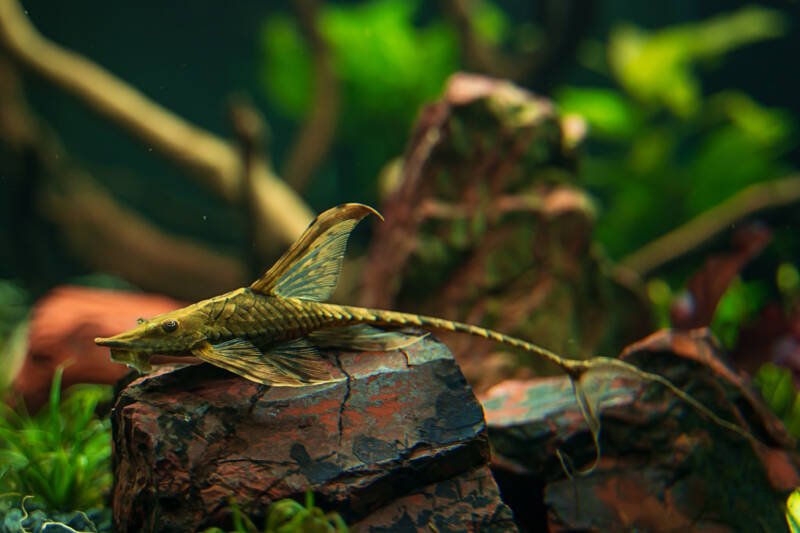
- Difficulty: Easy
- Temperament: Peaceful
- Diet: Omnivore, with a heavy emphasis on vegetables
- Tank Size: 30 gal (114 l)
This first unique fish on the list looks like it came all the way from the time of dinosaurs! It has an elongated, ultra-thin body and eye-catching, pointed fins. What makes it look so cool is the scales look like it’s wearing armor.
They measure eight inches (20 cm) in length and have an eight to 10-year lifespan. These fish favor the cooler, highly oxygenated waters found in fast-flowing streams.
They are slightly shy, keeping active in the nighttime hours until they are comfortable with their surroundings. A group of three to five fish may increase their comfort.
The royal farlowella catfish is a peaceful bottom dweller, which makes them ideal for a community tank with species that stick to the middle and upper levels.
Make sure they have nutrition in the form of sinking pellets or spot feeding.
2. African Butterflyfish (Pantodon buchholzi)
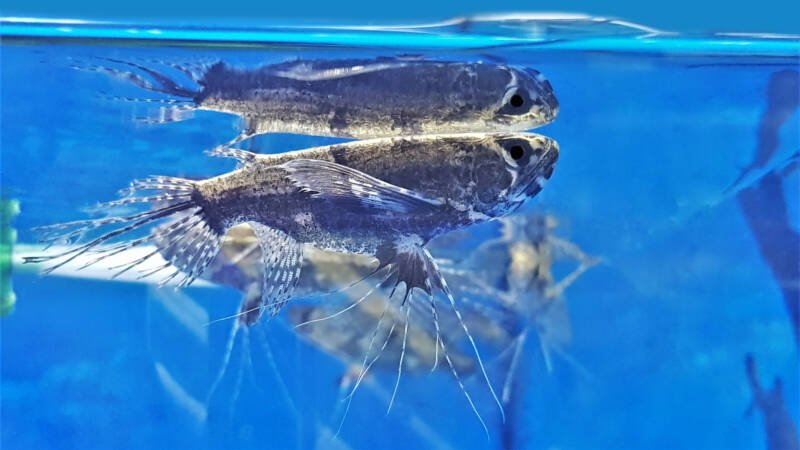
- Difficulty: Moderate
- Temperament: Semi-aggressive
- Diet: Carnivore
- Tank Size: 40 gal (150 l)
For a fish with unique abilities, check out the African butterflyfish. This amazing species can leap into the air, spreading its pectoral fins and gliding to escape predators!
When those fins are spread, they have the appearance of butterfly wings, thus the name.
This five-inch-long fish (13 cm) needs a large, long tank to accommodate its activity. They stick to the upper levels of the tank and are known to jump, so keep the tank lid secure.
They tolerate a narrow range of pH levels, necessitating regular maintenance of conditions.
These predators are also picky eaters, favoring live prey. Do not pair them with smaller fish species or those occupying the upper tank levels.
3. Black Ghost Knife Fish (Apteronotus albifrons)
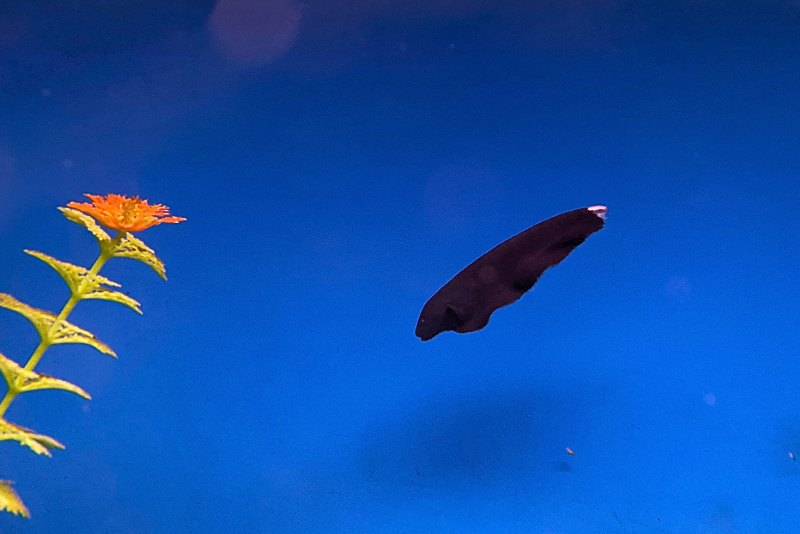
- Difficulty: Moderate
- Temperament: Semi-aggressive
- Diet: Carnivore
- Tank Size: 75 gal (284 l)
The Black Ghost Knife fish brings extra unusual shape and movement to your tank! Having no dorsal or caudal fins, they slip through the water using a rippling, veil-like fin that is almost the entire length of the fish. Stiff-bodied, so they look a little bit like a toothpick with wavy streamers on the bottom.
These fish are coal black with a true white stripe on the tail. As they age, many say the deep jet black does fade slightly into more of a deep gray color.
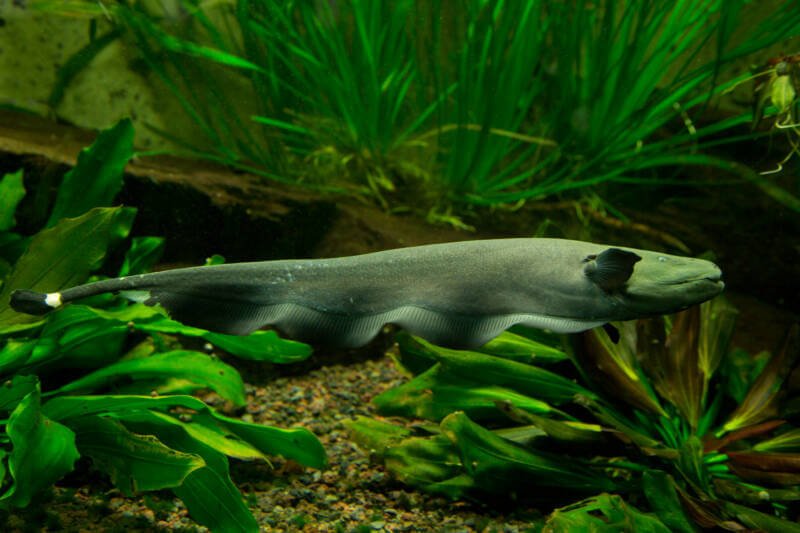
These nocturnal fish grow large, reaching around 20 inches (51 cm), they need a large aquarium with space to maneuver. You’ll often find them in the shops as juveniles only 4 inches, so in that case you have time to upgrade the tank size as they mature.
Black Ghost Knife Fish navigate their naturally murky waters using weak electric signals. This ability can make it difficult to keep two knife fish in the same tank as the conflicting fields cause stress. So this makes for a single highlight or feature specimen to keep.
They are micro predators, feeding mainly on insect larvae in the wild. If your specimen is wild-caught, you may need to train it to accept frozen foods, or freeze dried protein based ones.
4. Flowerhorn Cichlid (hybrid)
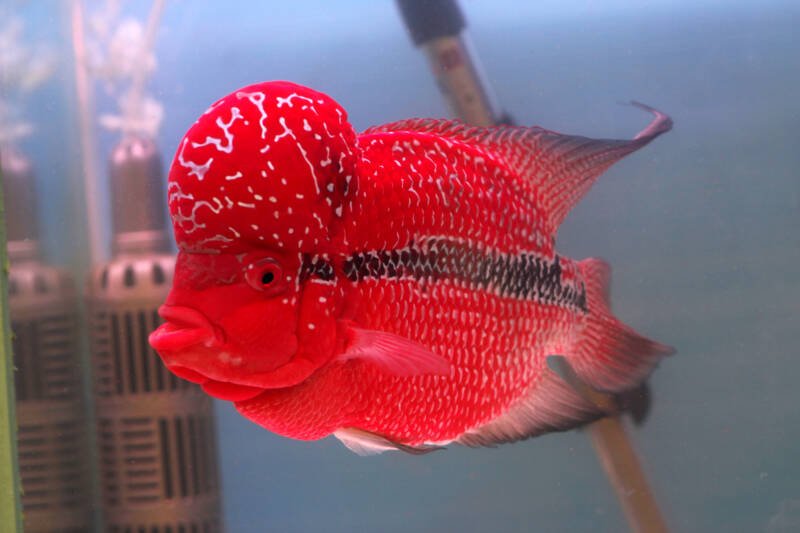
- Difficulty: Moderate
- Temperament: Aggressive
- Diet: Omnivore
- Tank Size: 70 gal (265 l)
The flowerhorn cichlid is an attention-drawing fish with bright colors, an oversized nuchal hump, and chubby jowls.
Bred from the combination of the blood parrot cichlid and the red devil cichlid, these fish have an impressive lifespan of 11 to 12 years.
They are large fish, reaching anywhere from 12 to 16 inches (30 to 40 cm) as adults, and need adequate space to move around.
They get by with minimal tank decorations and love to dig, so supply a sandy substrate and secure any plants or rocks.
They do well as a single specimen. If you add additional fish, know the flowerhorn’s tendency for territorial aggression and be prepared to rearrange your tank.
5. Marbled Hatchet Fish (Carnegiella strigata)
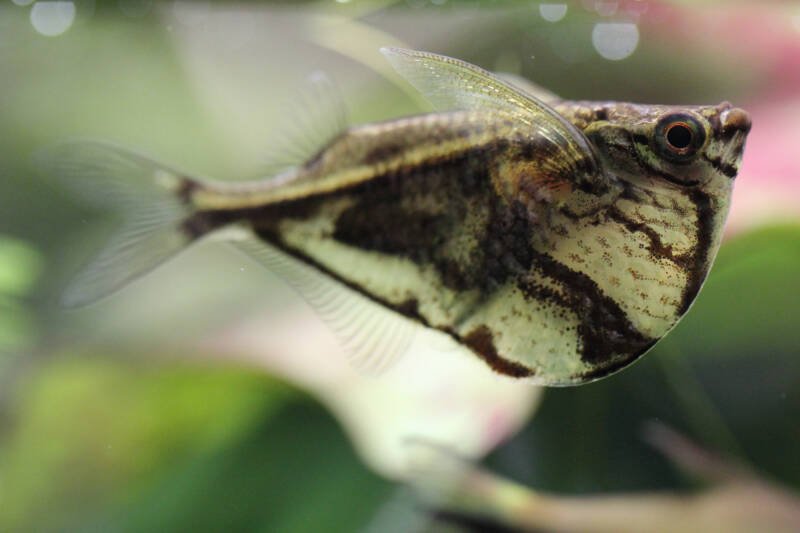
- Difficulty: Moderate
- Temperament: Peaceful
- Diet: Carnivore
- Tank Size: 20 gal (76 l)
The hatchet fish has a unique shape with a downward extending belly resembling the keel of a ship. What’s not to love about these fish! The marbled name comes from the unique stripe pattern which kind of looks like marbled rye bread.
This cool top-dwelling fish has powerful pectoral muscles that allow it to leap out of the water and skim the surface to escape predators. As such, keep the tank lid secure.
The marbled hatchet reaches around 1.8 inches (4.5 cm) in length and has a yellow/green and olive marbled color pattern.
There is a more common Hatchet fish species which are slightly more yellow on their back and do not have the marbled stripes, but the shape of this fish is what makes it cool.

When you first bring them home, they may be nervous and refuse to eat, but once established, they are hardy and voracious eaters.
They stick to the water surface and rarely descend. Pair them with peaceful bottom-dwelling fish in a heavily planted habitat, including a few floating plants.
6. Elephant Nose Fish (Gnathonemus petersii)
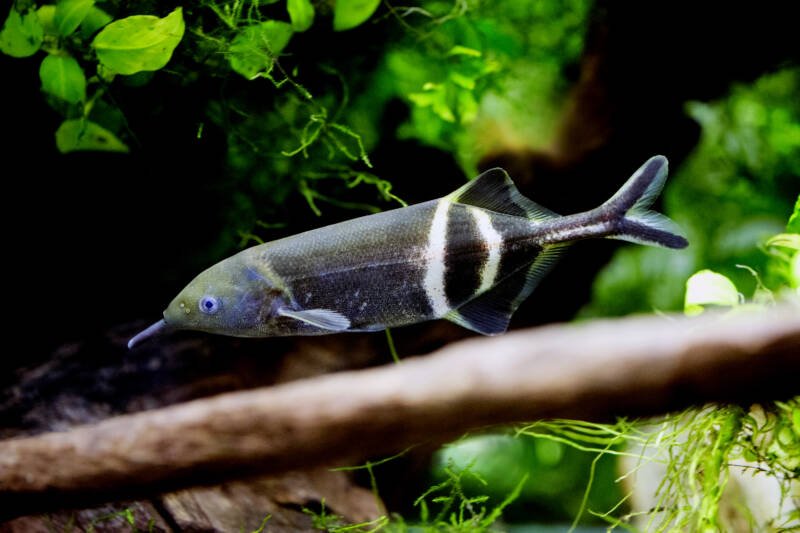
- Difficulty: Moderate
- Temperament: Peaceful, with mild territorial behavior
- Diet: Carnivore
- Tank Size: 50 gal (189 l)
The instantly notable feature of the Elephant Nose Fish is, you guessed it, its prominent Schnauzenorgan – a mobile, highly sensitive organ that permits electro-location.
Their nose emits and analyzes a weak electric signal, which allows them to perceive objects in the murky waters of their native habitat.
Color does vary from fish to fish and the overall health can dictate color vibrancy too. They are a dark body with lighter striped patterns that pop. Some Elephant fish are quite dark, almost black and others have brighter yellow/blue highlights on the top of the head. All will have some sort of light stripe on the tail end of the body.
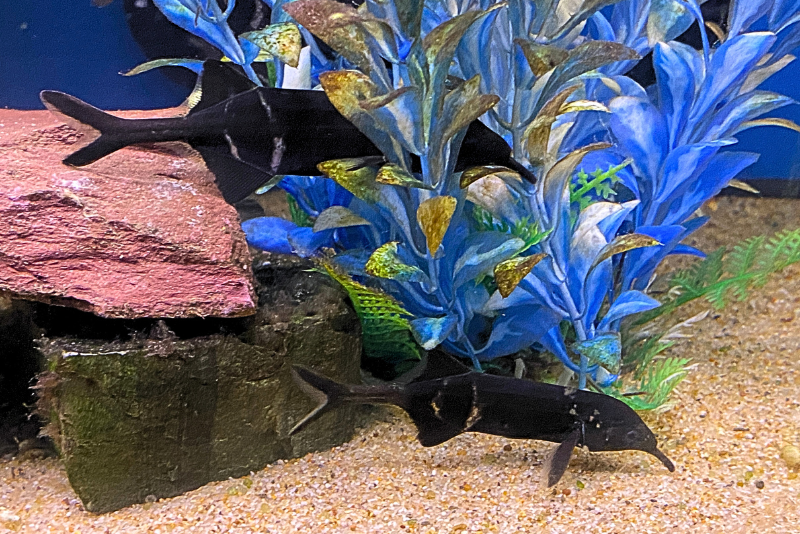
Expect your elephant nose fish to reach nine inches (23 cm) in length when fully grown.
A larger tank will allow for reduced territorial aggression and more opportunities to place objects and plants in the environment for your fish to explore.
Take particular care with water conditions for this fish and do not stretch these parameters when pairing them with other species in a community tank.
7. Hillstream Loach (Sewellia lineolata)
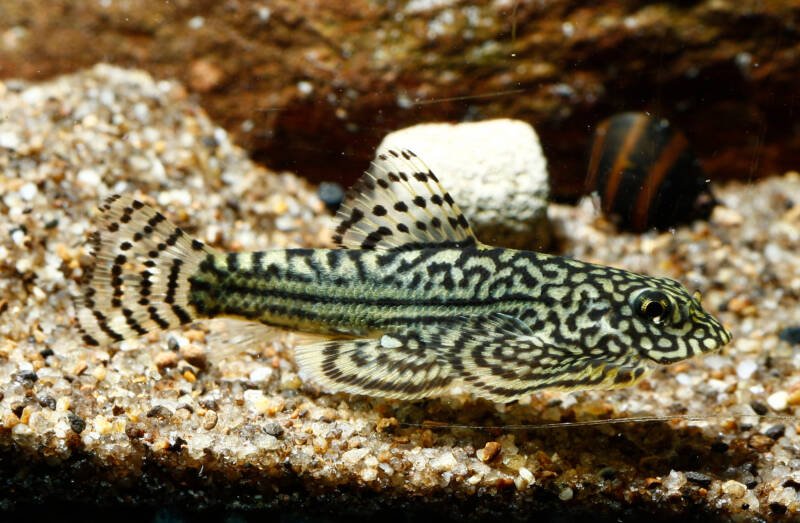
- Difficulty: Easy
- Temperament: Peaceful
- Diet: Omnivore
- Tank Size: 50 gal (189 l)
The hillstream loach looks more like an ocean-dwelling stingray than a freshwater fish.
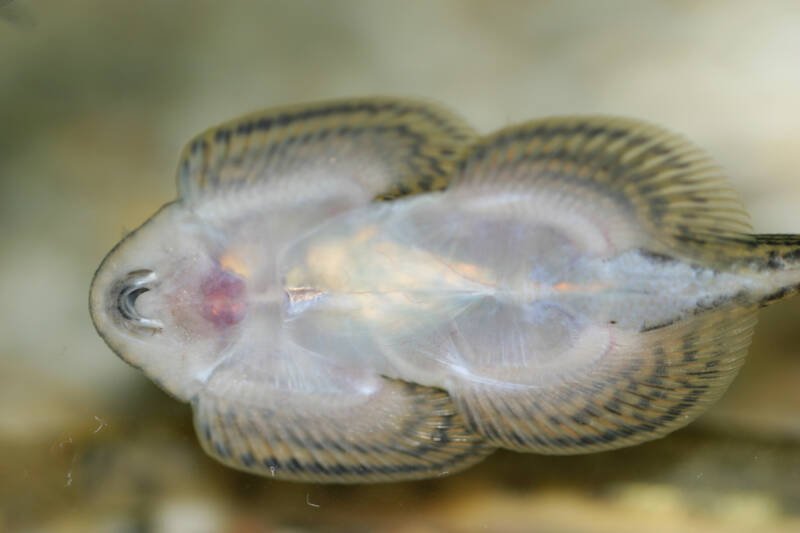
Streamlined and hugging the substrate, their fins flare out sideways like fans. Their body features a pattern mimicking light on the stream’s bed.
They have a long lifespan of eight to 10 years and reach a maximum of two to three inches (5 to 8 cm) in length.
You may be surprised by the recommended tank size for such a small fish. They need a strong current flow to replicate their natural waters, which is difficult to achieve in a small tank.
Hillstream loaches are most comfortable in a group of three to four individuals. Pair them with fish that favor similarly cool water conditions.
8. Glass Catfish (Kryptopterus vitreolus)
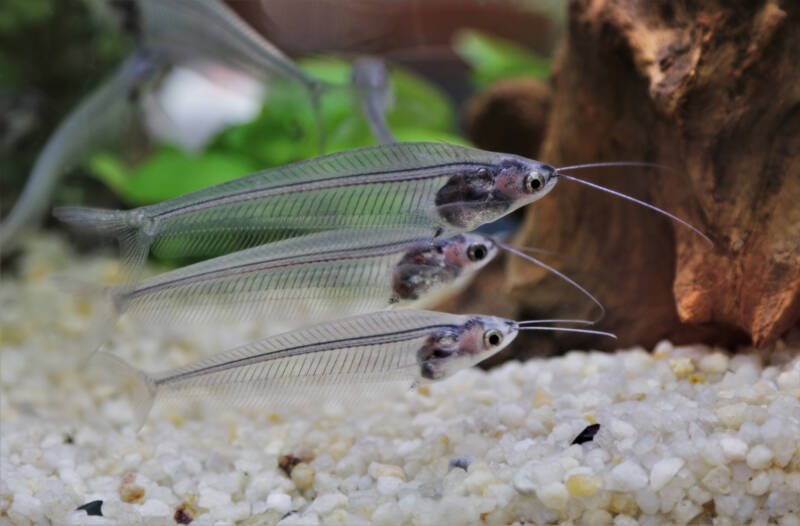
- Difficulty: Moderate
- Temperament: Peaceful
- Diet: Omnivore
- Tank Size: 30 gal (114 l)
How about a transparent catfish to add a dash of “WOW” to your tank? These unique natives to Thailand are not your typical, bottom-dwelling catfish.
You will find these active swimmers happily exploring the middle levels as well.
These fish are not tiny, either. At their adult length between four to six inches (10 to 15 cm), you will have no trouble seeing them.
Glass catfish have a long, eight-year lifespan and are healthiest when kept in a group of at least five.
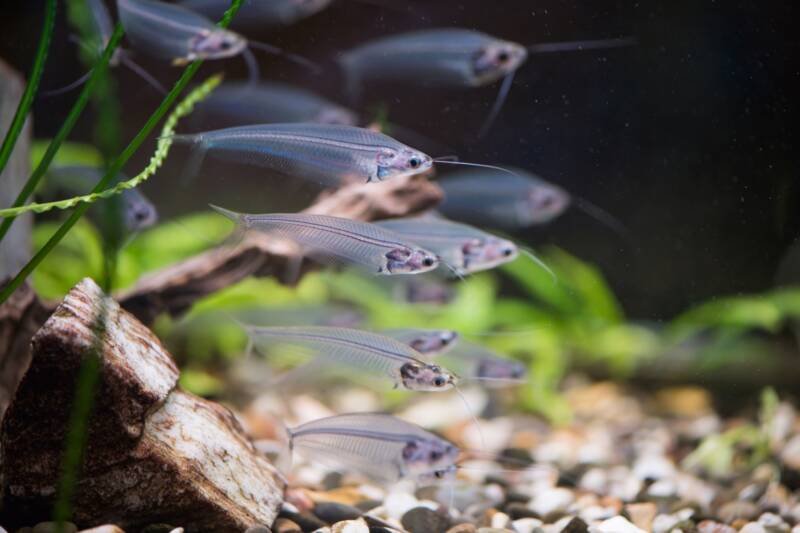
They have a narrow range of water parameter tolerance. Strict monitoring and maintenance of tank conditions is required.
They are excellent in a community tank with other peaceful fish of equivalent size.
9. Pea Puffer (Carinotetraodon travancoricus)
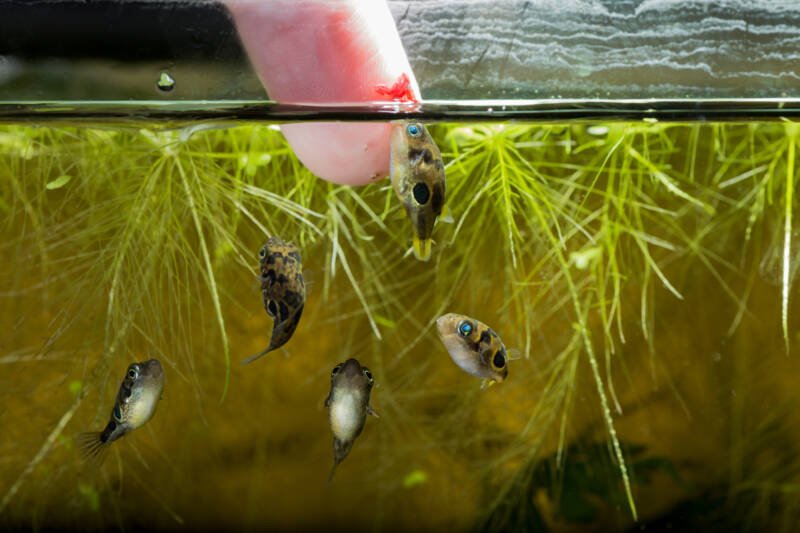
- Difficulty: Moderate
- Temperament: Aggressive
- Diet: Carnivore. Predator
- Tank Size: 10 gal (38 l)
The plump, big-eyed pea puffer certainly wins in the “adorable” category. This tiny fish buzzes through the water using almost invisible fins.
While they only reach around an inch and a half (3.8 cm) in length, you can get away with a smaller tank.
Still, a larger tank gives this active swimmer a little space to roam and allows the addition of plants and hiding places to create a comfortable environment and reduce stress.
This tiny predator needs a steady supply of frozen and fresh meaty foods.
They can also be quite aggressive for their size. Place them in a single species tank or pair them with fast swimming, shorter finned fish.
10. Paradise Threadfin (Polynemus paradiseus)
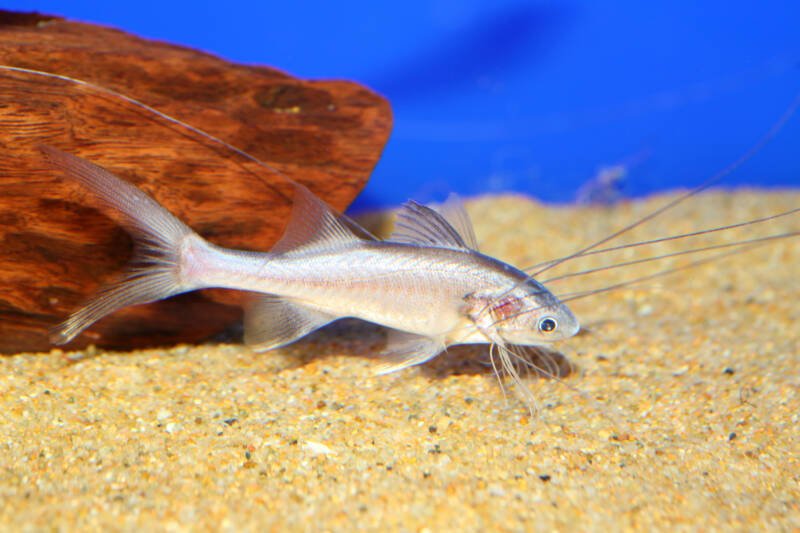
- Difficulty: Difficult
- Temperament: Peaceful
- Diet: Carnivore
- Tank Size: 120 gal (454 l)
- Size: 6-12 inches
The paradise threadfin is both a freshwater and marine species.
They are active swimmers that inhabit coastal areas of the Eastern Indian Ocean and Western Pacific and regularly return to freshwater for breeding.
These fish reach between 6.7 to 12 inches (17 to 30 cm) in length and have highly elongated, wispy appendages that they use to navigate their environment. In their native waters, locals harvest them for consumption.
They are quite sensitive to shifts in water parameters and are best for those aquarists with experience in maintaining steady conditions.
They need alkaline pH levels, warm water, and zero levels of both ammonia and nitrites.
11. Amazon Leaffish
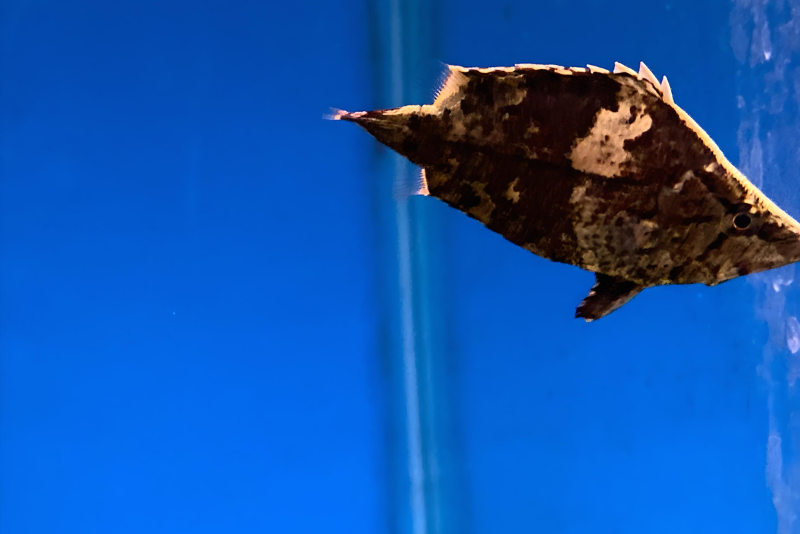
- Difficulty: Expert
- Temperament: Shy and Hides
- Diet: Carnivore. Ambush predator
- Tank Size: 30 gal ( l)
- Size: 4-5 inches
Leaffish have evolved to be incredible camoflouged freshwater fish earning a spot on the list for extremely unique display fish. They are ambush predators that mimic a dead, floating leaf, waiting to swallow their prey whole.
Overall they are peaceful with any fish larger than a meal size, but can show stress with more aggressive fish that would pick and bite at them. Although they can be moderately hardy when it comes to water parameters, where they become expert level is the difficulty in feeding live foods and insects, and ensuring they actually eat (other aggressive feeding fish will beat them to it and they starve).
Your tank should be densly planted for the leaffish to thrive, with temperatures at 78-82°F
Unexpected & Oddly Shaped
1. Ropefish (Erpetoichthys calabaricus)

- Difficulty: Easy
- Temperament: Peaceful
- Diet: Carnivore
- Tank Size: 50 gal (189 l)
Ropefish rank high on the list of coolest fish! Long and snake-like, the Ropefish hardly looks like a “fish” at all. Their coloration and body shape help them blend into the densely vegetated, slow-moving waterways from which they hail. Now this fish might be perfect for you or a little too weird – and that’s ok.
What is notable about Ropefish is their face. They have a comical, almost smiling demeanor that some people just cant get enough!

These fish are highly adaptable and tolerate both fresh and brackish water. On top of that, they have both gills and lungs, making them incredibly hardy in a range of water conditions.
As a bottom dwelling fish, they scan the substrate for bites to eat, scooting along in long sweeping eel-like movement. Ropefish need a cave to hide, but will definitely be out and about exploring the tank.
They reach up to two feet (61 cm) in length when fully grown, so plan ahead with a sizable tank once they reach adulthood.
If you are looking for a unique fish that will stick around for a long time, the Ropefish will not disappoint. With excellent care, they can live anywhere from 15 to 20 years!
2. Bichir (Polypterus delhezi) or (Polypterus senegalus)
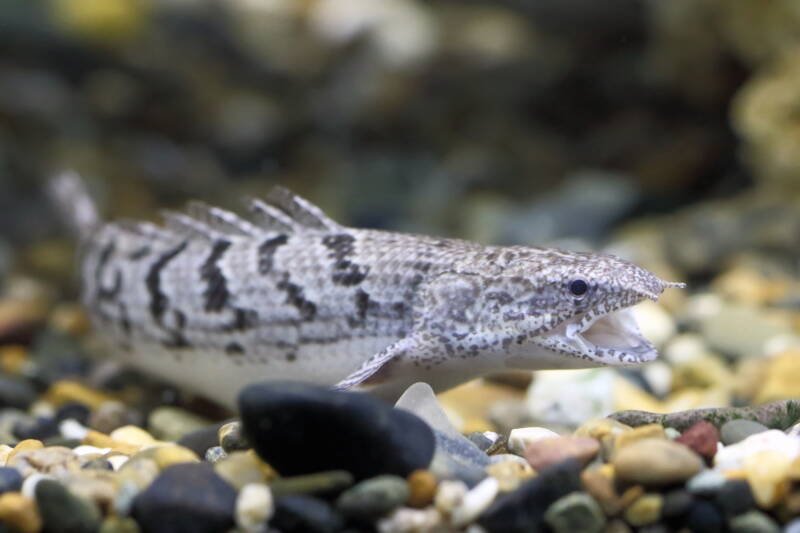
- Difficulty: Moderate
- Temperament: Peaceful (but aggressive toward their own kind)
- Diet: Carnivore
- Tank Size: 100 gal (379 l)
There is no denying the appeal of the prehistoric-looking bichir. There are several varieties, with P. delhezi and P. senegalus being popular for home aquariums.
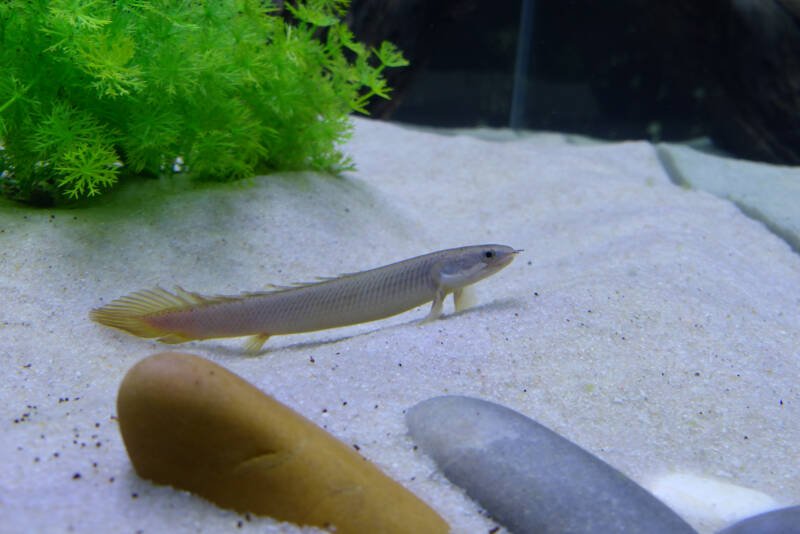
These nocturnal carnivores are incredibly hardy fish and hail from shallow, muddy rivers in Africa. They get along well with other species but do not enjoy having others of their kind in the same tank.
Depending on the species, they range in size from 17 to 20 inches (43 to 51 cm). They need a long tank with sufficient space for swimming.
They also need access to the water surface to breathe from time to time. In doing so, be aware they can jump, so a tight-fitting lid is required.
3. Stingrays (Potamotrygon genus)
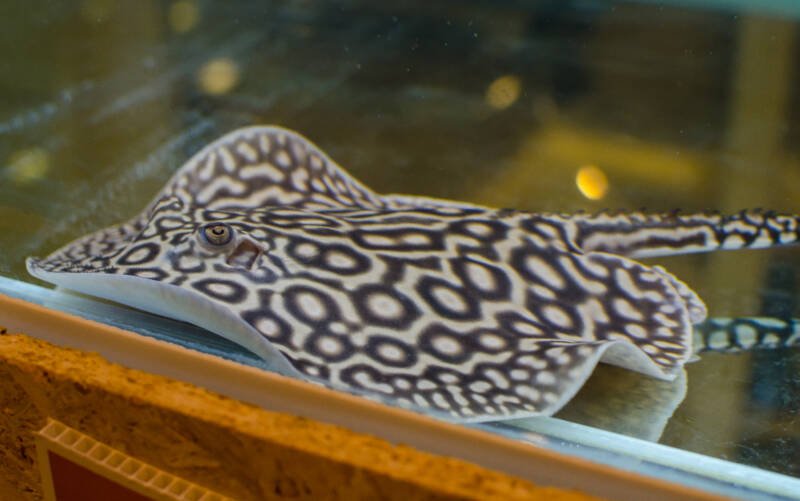
- Difficulty: Moderate to Difficult
- Temperament: Peaceful
- Diet: Carnivore
- Tank Size: 250 gal (946 l)
There are a variety of freshwater stingrays under the Potamotrygon genus that are popular for home aquariums.
They range from 30 to 36 inches (76 to 91 cm) in diameter and feature striking patterns in brown, olive, or black.
You will need a significant tank size with ample floor space and a robust filtration system to provide the best environment for this fish. They do not tolerate shifts in water parameters well.
The scaleless ray has a poisonous stinger but is peaceful in nature, with only slight aggression from the male during breeding times.
Avoid keeping different species under the same genus together, as they can produce unwanted hybrids.
4. Vampire Tetra (Hydrocyon scomberoides)
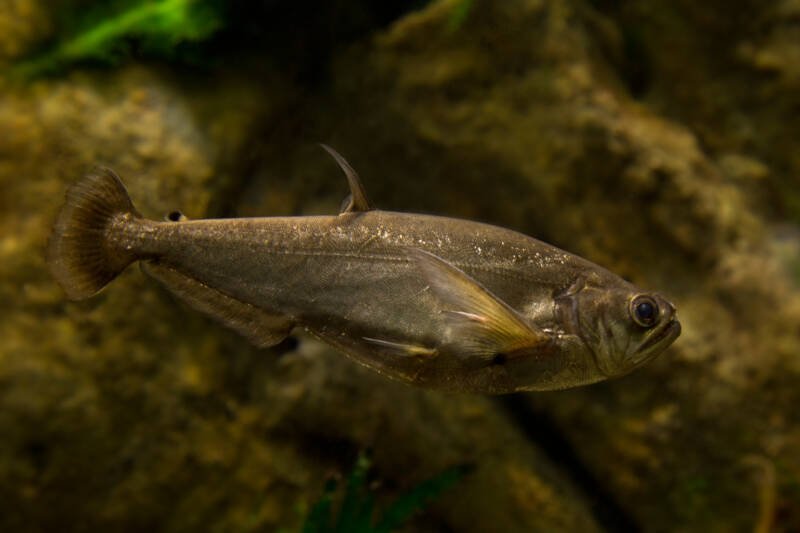
- Difficulty: Moderate
- Temperament: Aggressive
- Diet: Carnivore
- Tank Size: 500 gal (1893 l)
If the name “vampire tetra” did not catch your attention, how about the fact that this monster eats piranhas in the wild? Interested now?
This fish is built for speed and hunting, with a sleek body, upturned mouth, and huge fangs.
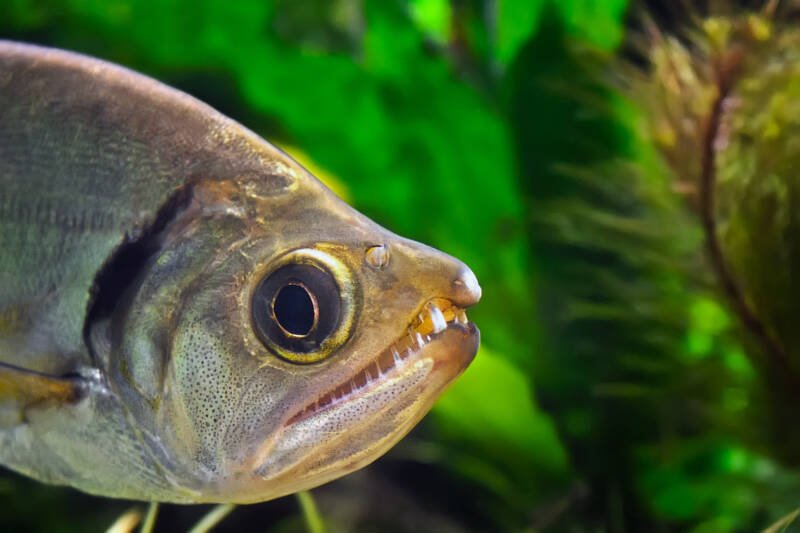
While they reach up to four feet in length in the wild, in a home aquarium, they stay around 12 inches (30 cm). Still a sizable fish and substantial investment in tank size and a filtration system!
The vampire tetra can be trained to accept frozen foods but prefer live prey.
Note as well that for such a large fish, the vampire tetra has an oddly short lifespan of only 12 months.
6. Kuhli Loach (Pangio cuneovirgata)
- Difficulty: Moderate
- Temperament: Peaceful
- Diet: Omnivore
- Tank Size: 10 gal (38 l)
There are multiple species under the Pangio genus that go by the name “kuhli loach.” Of these, P. cuneovirgata is one of the smallest.
They have the same saddle-like stripes and long, elegant shape, just in a more compact, two-inch (5 cm) size.
When frightened, their instinct is to rapidly bury themselves under the sand, so a soft substrate is needed to protect them from injury.
Make sure your tank is well established before adding your kuhli, and cover the filter intakes to prevent these curious fish from becoming trapped.
Kuhli are peaceful fish that make great tank mates. They show higher activity levels when kept in a minimum group of three.
Closing Thoughts
With so many aquarium fish from which to choose, building and stocking your dream tank is easy!
As always, do your reading, talk to your local fish store, and visit online forums to make sure you are providing the best environment for your cool freshwater fish.